Top 10 SEO Mistakes Business Owners Need to Avoid
When business owners start implementing SEO, it is easy to make mistakes that can undermine the effectiveness of their Google SEO efforts and end up costing them a lot of money. With 3 years of experience in SEO, MAU Agency will share the top 10 mistakes that business owners should avoid when implementing Google SEO.
| Table of Contents |
There is no one-size-fits-all SEO optimization strategy
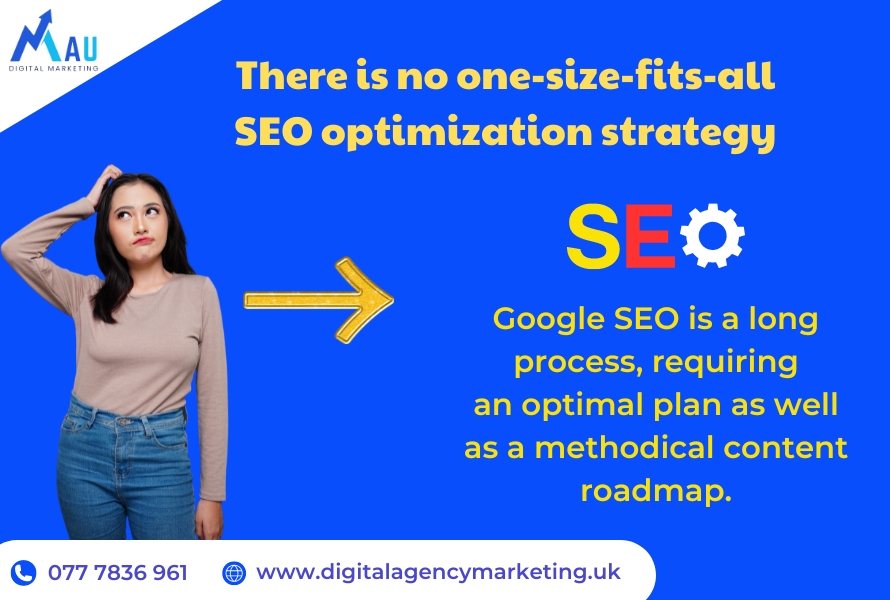
Building a long-term strategy is the most important consideration when implementing SEO. Many small businesses think SEO is only a short-term tactic, so they often fail to invest adequately in it. This is a common SEO mistake that can hinder the successful implementation of an effective Google SEO strategy.
Google SEO is a long-term process that requires a well-planned approach and a methodical content roadmap. To build a successful long-term SEO strategy, you need to carefully consider factors such as your product, website, content, techniques, UX/UI, and even external PR factors. Addressing all these elements is what will ultimately bring meaningful benefits to your business website.
Conversely, failing to build an optimal SEO strategy will waste of time and money without producing the desired results.
Patience is the main key when doing SEO
As mentioned above, Google SEO is a long-term process, so patience is essential. A common mistake is thinking that SEO can deliver immediate results within 2-3 weeks. Due to this misconception, many business owners prematurely conclude that the SEO campaign is ineffective and end it.
In reality, an SEO campaign typically requires at least 6-10 months from the start of implementation to start seeing meaningful results. MAU Agency has extensive experience in executing SEO projects for many businesses, and we can confidently state that 6 months is a reasonable timeframe to see the positive outcomes that SEO can bring to your business. From there, you can continue to optimize your website.
An ill-conceived keyword strategy can sabotage your SEO efforts
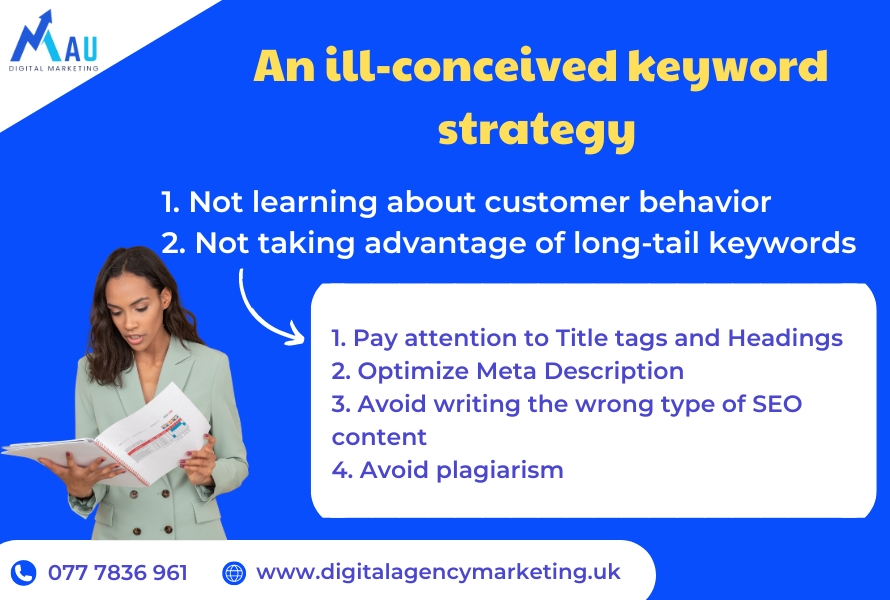
Building an effective keyword strategy is not a simple task. Many business owners make mistakes in this area when implementing Google SEO, which can lead to their website being undervalued. Two common mistakes to avoid are:
Failing to understand customer behavior:
Before creating content for your website, the most important step is to thoroughly understand your target customers. If a website publishes content with keyword types that do not align with customer needs, it is unlikely to attract much engagement. Worse, this SEO mistake can even cause Google to mistakenly flag the website as spam and remove it.
Keywords are a crucial component of SEO, but if the website fails to research customer behavior and search intent, the selected keywords will be meaningless. Therefore, before creating content, you need to carefully research your customers' behavior and understand what information they are seeking.
Neglecting long-tail keywords:
Many businesses new to SEO tend to focus solely on short-tail keywords. This is a common SEO mistake that can prevent a website from ranking well on Google. Short-tail keywords typically have very high search volumes but also highly competitive, making it challenging for new businesses to compete with established players.
Long-tail keywords, on the other hand, can be a powerful solution to increase your website's competitiveness. Long-tail keywords are more specific and better reflect the user's search intent. Although they may have lower search volumes individually, they can collectively drive significant traffic to your website and help you reach the top search results.
-
Examples of short-tail keywords: Handbags, Men's Jeans, SEO Services
-
Examples of long-tail keywords: Prices for brown women's handbags, Men's denim jeans, Reputable SEO services
Therefore, businesses should avoid the above mistakes and focus on understanding their customers' behavior and search trends. Utilize a balanced approach between short-tail and long-tail keywords to optimize your SEO strategy.
SEO is not just about techniques, but also content
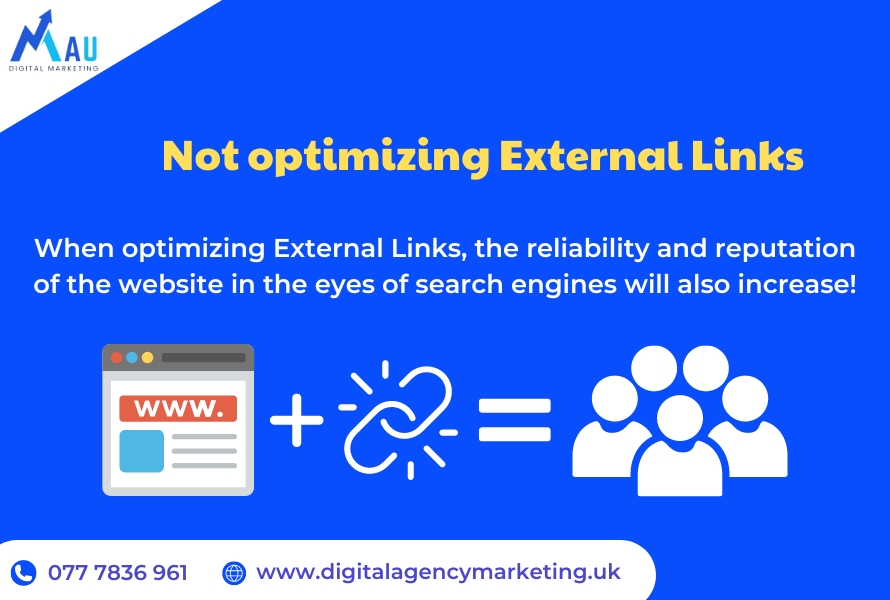
Many businesses make the mistake of considering SEO purely as a technical exercise, overlooking the importance of content. This approach can significantly reduce the effectiveness of their SEO strategy. Quality content is a crucial pillar, as it provides real value to users and attracts the attention of search engines like Google.
Therefore, it is essential to invest in creating high-quality, informative content that benefits your customers and your business. Here are four key aspects to consider, as neglecting them can negatively impact your page rankings:
Pay attention to Title tags and Headings:
Title tags and Headings (such as H1, H2, H3) play a vital role in optimizing SEO for your website. Title tags are crucial for attracting user attention and search engine algorithms, while Headings help organize content and improve page readability. Make sure to use appropriate keywords and descriptions that align with the content to optimize these elements.
Optimize Meta Descriptions:
Similar to Title tags and Headings, Meta Descriptions also play an important role. Ensure your Meta Descriptions are concise, engaging, and include relevant keywords to entice users to click on your website when they see it in search results. Neglecting to optimize Meta Descriptions is a common SEO mistake that can impact your click-through rates.
Avoid creating the wrong type of SEO content:
This is a fundamental mistake in implementing SEO, and it can also harm the reputation of your website in the eyes of Google. Keywords are what bring customers to your website, but the content is what keeps them engaged. Content that does not provide value to customers can lead to high bounce rates, which can negatively impact your website's ranking.
Ensure you create high-quality, informative content that reflects your expertise and understanding of the subject matter. Incorporate keywords naturally and appropriately without compromising the user experience.
Avoid plagiarism - a taboo mistake in Google SEO:
Plagiarism, or copying content from other websites, is a major taboo in the world of Google SEO. A website that lacks original, valuable content and simply replicates content from other sources provides no real value. Many businesses mistakenly believe that Google won't detect this, but in reality, Google has sophisticated mechanisms to identify and penalize plagiarized content.
Plagiarism not only undermines the credibility of your website but can also result in penalties from Google. Furthermore, a lack of unique content can erode trust from customers and negatively impact the overall performance of your website.
By avoiding these common SEO mistakes and focusing on building a comprehensive, long-term strategy, incorporating customer-centric content, and utilizing a balanced keyword approach, businesses can significantly improve the effectiveness of their Google SEO efforts and achieve sustainable success online.
Neglecting External Links
One common mistake in implementing an SEO strategy is failing to optimize external links. This oversight can result in missed opportunities to significantly improve a website's ranking in search engines.
External links, also known as outbound links, play a crucial role in establishing a website's reputation on the internet. By not optimizing these links, you miss the chance to enhance your website's trust and authority in the eyes of search engines.
For example: If you operate a nail salon, linking to nail art tutorials on reputable sites like Allure, Glamour, or Elle can boost your website's industry standing. Additionally, sharing links to articles or images from social media platforms like Instagram or Pinterest about beauty tips or nail art can effectively increase engagement and awareness of your website..
Moreover, linking your website to social media platforms like LinkedIn, Twitter, or Facebook can create robust connections. Search engines value links from reputable and interactive websites, which helps improve your site's position in search results.
Overlooking Page Load Speed and Layout Optimization
Another common SEO mistake is not optimizing page load speed and layout, which can create a poor user experience and negatively affect SEO performance. A website with a complicated interface, unclear menus, and poorly placed navigation buttons, coupled with slow loading speeds, can deter users from staying.
For example: A hair salon has a website with a complicated layout and slow loading speed. When customers visit the website, they spend time waiting for the website to appear, but in the end, before their eyes is a "forest" of confusing interfaces. Therefore, they may leave the website and look for results from other competitors.
Trying to Manipulate Google Rankings
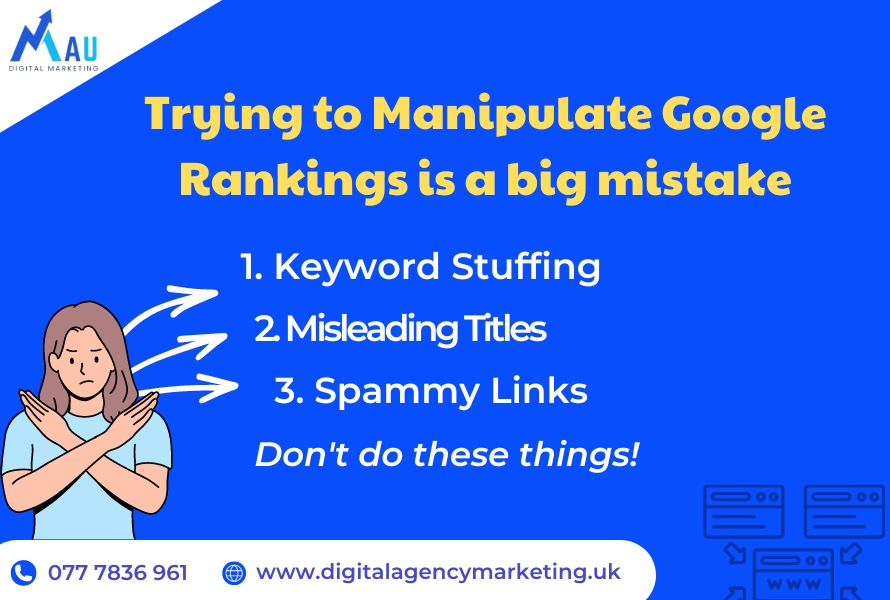
Attempting to manipulate Google rankings is a serious mistake that can severely harm your SEO efforts and lead to penalties from Google. With four years of experience in SEO, MAU Agency advises avoiding the following:
Keyword Stuffing
Keyword stuffing is to find a way to repeat one or several SEO keywords in the article content to be able to rank on Google. This not only makes readers feel that the article is unnatural but also makes them feel uncomfortable.
To solve this problem, Google has released an algorithm called Google Panda to scan and penalize websites that intentionally do this. The highest penalty is deletion of the website.
Misleading Titles
This is the most obvious SEO mistake because it takes the form of providing content that is different from the article title, causing discomfort to readers and severely affecting the reputation of your business.
For example: A website titled “Beginner's Guide to SEO.” But when users access the website, it provides articles about gambling and football that do not bring any value to them and are also considered SPAM by Google.
Spammy Links
Link spam is the unnatural or intentional use of links between websites, with the aim of enhancing the website's position on search engines. This seems to be a disastrous SEO mistake that some websites have tried. However, Google easily recognizes these forms of spam, and can penalize websites by reducing rankings or even removing them from search results.
Here are 5 Specific examples of types of spam links:
-
Spam links with unrelated content: A travel site that places links to a site that sells electronic products, without any links about travel or related topics.
-
Spam links in comments: Some fake accounts are created on sports forums, then comment with meaningless or spam content and attach links to online sales websites.
-
Links on social networks: An individual creates a series of fake accounts on Facebook and then shares posts unrelated to the content of their website, but still inserts links to their sales website in the posts.
-
Trading spam links: Two pet care and beauty websites created a link purchase agreement in which they would link to each other without any association in terms of content or benefit to users.
-
Use automatic Spam tools: An SEO company uses automated software to create thousands of posts on forums and blogs with unrelated content, but still links to their site, in an attempt to increase rankings on the engines. search
Ignoring Mobile Optimization
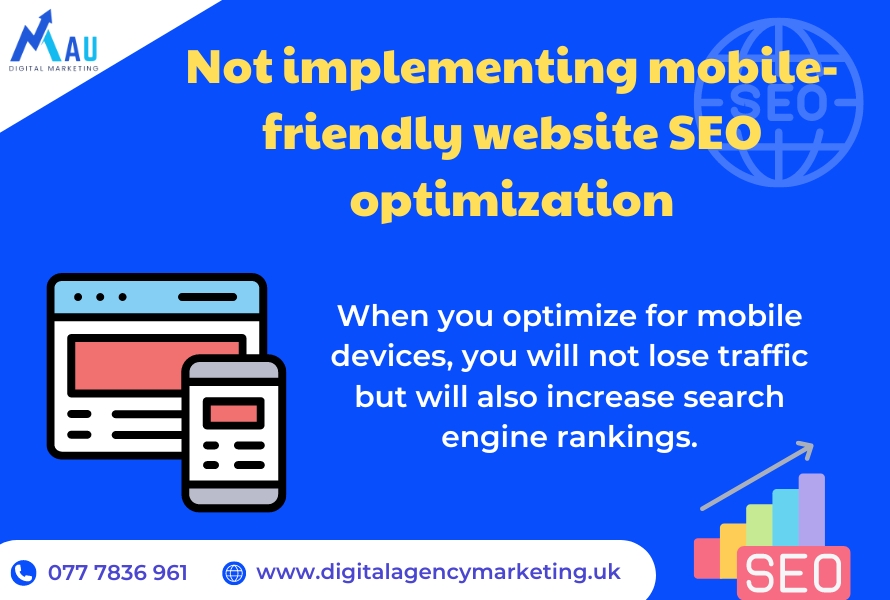
This is an SEO mistake when you build a website but do not have mobile support or the responsive interface is not good enough. Failing to optimize your website for mobile devices is a critical SEO mistake.
Mobile users may face navigation issues, difficulty viewing product details, and poor image quality, leading them to leave your site for better mobile experiences elsewhere.
The consequence of this is not only loss of traffic but also impact on search engine rankings.
Neglecting Image Optimization
Not optimizing images is a mistake when implementing SEO and this can cause many problems in optimizing the website for search engines. Using large or suboptimal images can increase page load times, cause a poor user experience, and reduce site interactivity.
That can lead to a decrease in a site's ranking on Google, because Google evaluates factors such as page load speed and user experience when determining a site's ranking in search results. Therefore, do the 2 things below to optimize images to ensure your website ranks high on Google.
Always leave Alt Text
Alt text (alt text) is an important part of optimizing images on a website. Alt text is a piece of text that describes the image and it is displayed when the image cannot be displayed or when the user hovers over the image.
Not only does this improve user experience, but it also helps search engines understand the content of the image and increases the site's visibility in search results related to that image. But quite a few businesses make the mistake of skipping this Onpage SEO optimization step.
Pay attention to image captions
Some businesses make the SEO mistake of omitting content captions for images, which can result in lost opportunities to appear in search results related to that image. At the same time, unclear or inaccurate captions can reduce the user experience, making it difficult for them to understand and interact with the website, which can lead to them leaving the page and searching for information. from another source.
Image captions are an important part of website optimization. When annotating images, make sure that the descriptions are clear, coherent, and related to the main content of the page. This way, not only users but also Google can understand the content of the image.
Backlink stuffing - A mistake that prevents a website from reaching the top of Google SEO
Backlink stuffing, also known as creating or buying links unnaturally or from unreliable websites, is one of the big mistakes when implementing an SEO strategy. Not only do they not provide value to readers, but they can also have the opposite effect and affect the site's position on Google.
Building natural and valuable backlinks is key to improving your website's position in search results.
Not measuring and evaluating results is always a common mistake when optimizing SEO

Not measuring and evaluating results is a common mistake when performing SEO optimization. This always leads to a lack of understanding of the performance of the SEO strategy, losing opportunities to improve and adjust the strategy according to actual results.
By tracking and measuring 4 indicators such as traffic, conversion rate, keyword rankings, and bounce rate. You'll be sure to get important metrics on whether the strategy is working or not.
Conclusion
MAU Agency hopes this article has highlighted 10 common SEO mistakes to avoid. While starting with SEO, mistakes are inevitable, but understanding these pitfalls can help you improve your strategy and elevate your website to the top of Google's search results.
Jump to: Overall Digital Marketing service
--------------------
DIGITAL AGENCY MARKETING UK
Add: 133 Creek Road, London SE8 3BU
Tel: 077 7836 9618
Email: admin@digitalmarketingagency.uk
Website: https://digitalagencymarketing.uk/
Tin tức khác
10 Comprehensive Steps to Craft an SEO Strategy and Dominate the Market in 6 Months
Pricing 10+ Type of SEO Cost That Business Owners Should Pay Attention
Top 10+ SEO KPIs | 6+ Determination Steps, 5 Notes, 4 Benefits You Cannot Skip
Can Business Owners Become SEO Experts?
11+ Steps to Create a 6-Month Overall SEO Plan for New Businesses


